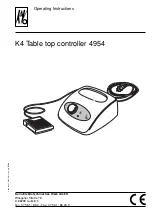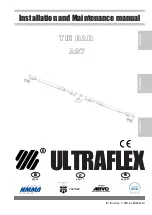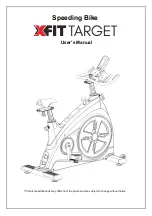
3-12
HYDRAULIC SYSTEM
The IC-100 hydraulic system consists of two subsystems, driven by a double pump with
a single inlet port. The 16 GPM (61 L/min) vane pump supplies the hydrostatic steering
function and the boom and outrigger functions. The hoist and brake booster are
powered by the 32 GPM (121 L/min) vane pump.
The boom, outriggers, hoist and optional front winch are controlled by one valve
assembly. The 16 GPM (61 L/min) pump flow enters the steering flow control valve first
and then flows into the left-hand section of the control valve assembly supplying the
swing, telescope, boom and outrigger sections. The flow from the 32 GPM (121 L/min)
pump enters the brake booster flow control valve first and all but 4 GPM (15 L/min) is
directed to the inlet section to the left of the hoist valve. Adjustment procedures for the
crane hydraulic functions are given on page 3-18 through 3-20. The schematic of the
hydraulic system is shown on the next page.
STEERING SYSTEM
The three-mode steering system is shown in the schematic on the next page. The IC-
100 steering system is a load-sensing, demand-type system that takes only as much
flow as is needed when steering and directs the excess flow to the control valve for
boom and outrigger functions. The priority flow-control valve is in the line between the
16 GPM (61 L/min) pump section and control valve.
Oil from the 16 GPM (61 L.min) section of the pump goes into the priority valve at port
"P." When no steering is required, the entire flow goes through the priority valve and
leaves through port "EF" to the crane valve. The crane operating speed is not affected,
since there is no loss of volume passing through the priority valve.
When the steering wheel is turned, the load-sensing line signals the priority valve to
divert the required amount of oil to the steering control unit to meet the steering system
requirements. The excess oil, not required for steering, flows to the crane control valve
as usual. Since the amount of oil required for steering is usually a small portion of the
pump output, the crane control valve is always operational while the unit is being
steered. Crane operation speed is reduced such a slight amount it is usually not
noticed.
The steering control unit is non-load reactive. This means that bumps, curbs, and
obstacles cannot change the steering angle and are not felt in the steering wheel. It also
means that the wheels do not re-center when the steering wheel is released. The
steering wheel must be turned back to center at the end of a turn.
There is a check valve in the pressure line between the priority valve and the steering
control unit. This prevents pressure in the steering cylinders from venting back into the
pressure line when the pressure is low. This eliminates steering wheel kickback when
the steering wheel is released. The steering system pressure was set at 1900 PSI (131
bar) at the factory, and this should not need adjustment.
The three steering modes are selected by a switch on the dashboard which activates the
automatic alignment system. Electronic proximity sensors and logic controls delay the
switching of the steering mode until the wheels are centered. The proximity sensors
should be cleaned periodically with a rag to prevent dirt buildup from blocking their
operation.
Summary of Contents for IC-100-3A
Page 6: ...1 2 IC 100 3A DIMENSIONS...
Page 7: ...1 3 IC 100 A TURNING DIMENSIONS...
Page 18: ......
Page 33: ...2 15...
Page 52: ...3 8 IC 100 LUBRICATION CHART...
Page 57: ...3 13...
Page 58: ...3 14...
Page 68: ......
Page 69: ......













































